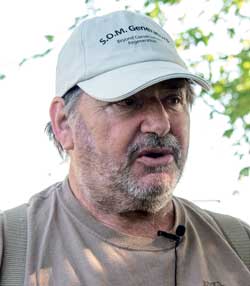About a year ago, I read an article that said the greatest export from the State of Iowa down the Mississippi by weight wasn’t corn, soybeans or some livestock product, but topsoil.
If this had been 50 years ago, with the practices and the knowledge we had then, this would have been obvious, but today? With what we’ve learned about working regeneratively with nature? I wonder is there a time where we will pass the point of no return because of some people’s greed, lack of knowledge or resistance to change. Will there be the resources to provide for generations to come? Not just for this generation or our children, but 10, 100, 1,000, 10,000 generations from now — for however long people need this planet?
I’ve been thinking about how 2022 is my 50th year of making my living growing things as a farmer. I’m the third generation of Sommerfields to farm some of our land. Our son has been taking over the management and most of the work as the fourth generation. The first half of my farming career, I considered myself a conservationist trying to do what we were being told to do by the government agencies like Natural Resources Conservation Service and Soil Conservation Service to preserve the productivity of the land we farmed.
For the second half, we’ve been doing practices leaning more toward being “regenerists,” partnering with nature to grow our soils deeper and more productive. Regenerative resource management is emulating and improving on how nature provided the resource to begin with.
We’ve tried to educate people about regenerative thinking, the need for a holistic vision of what you’re hoping to accomplish and how it affects the entire community. By community I mean the whole natural community where man returns to an interdependent relationship with nature as a partner and guardian of all life.
Certainly not all organisms in the environment are beneficial, but by looking first to overloading the bad with overwhelming biodiverse healthy levels of beneficial has proven far more profitable and sustainable than turning first to pesticides.
We see nature as God’s operating system for the planet, with many of today’s problems resulting from the bug in the works being man. So many farming today are still locked into the corporate industrial “till and kill” mindset that makes ag corporations rich from high input costs.
Many on the land are not the farmers they believe themselves to be, but agricultural corporations mislead them into believing they can’t grow anything without excessive levels of industrial fertilizers, pesticides and energy. After decades of working with nature instead of against it, we have seen many of our cropland soils grow downward to depths twice or more than what they were 200 hundred years ago before settlers came to this area. Our soils have a structure and function more like virgin prairie than the hardwood forest soils they were.
Rain infiltration has improved sixfold to 85%, greatly improving our climate change resiliency. When growing crops like corn, our non-land out-of-pocket costs have been reduced, with about two-thirds coming from nature, not the industrial corporations.
It appears (to me, at least) that the talk about climate change has some truth in it. Droughts and desertification are driving famine in many regions of our world. I can only wonder what will it take for all producers on the land to change to managing the land so it grows more productive, not less. Is a time coming where the governments of the world demand how one is to farm — or not have a license to farm?
Related Content
Emulate Nature to Create and Sustain Soil Health
Three Strip-Tilling Tips from a ‘Regenerative Agriculturist’






